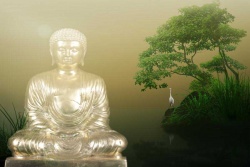Self-Development and Self-Transcendence in Theravada Buddhist Thought and Practice
By Peter Harvey, Professor of Buddhist Studies, University of Sunderland
At an intellectual level, Buddhism is known for its critique of any idea of an essential Self: everything is to be recognized as not-Self, anatta: not a permanent, fixed, autonomous I or metaphysical Self. At a practical level, it is known for its rich meditation tradition, using a variety of methods which can be seen to enhance self-development, cultivating such qualities as self-confidence, inner strength, and presence of mind. The question of how these fit together raises interesting questions, and ones which seem of relevance to the relation between self-enhancing Humanistic Psychology and potentially self-transcending Transpersonal Psychology.
Theoretical overview
Based on the analysis found in the Suttas of the Pali Canon, the collection of early teachings assembled by the Theravada school of Buddhism, what overview of the issue of self do we find?
i) It is emphasised that one should come to let go of attachment to everything that can be recognized as not-Self. As literally everything is to be seen as not-Self, this also implies that no permanent, essential, metaphysical Self exists.
ii) Yet the empirical person or self certainly exists: the changing, interacting bundle of mental and physical processes: body, feelings, perceptions/cognitions, constructing activities (will, emotions), and consciousness.
iii) Within the empirical self, the functioning centre of activity is citta, a term which includes something of both 'heart' and 'mind'; it is equivalent to consciousness as configured in a series of constantly changing mind-sets.
iv) Also within the empirical self, at least for all unenlightened people, is the sense of 'I am': an imprecise attitude or gut-feeling of 'I', ego, self-importance or self-centredness, consciously or unconsciously based on the idea of a fixed me, an unchanging I, and thus on a delusion. It may take the form of a sense of superiority, 'I am superior', inferiority 'I am inferior', or competitive or complacent equality, 'I am equal'. Each of these circles round and tries to draw attention to 'me, me', rather than just recognizing what qualities self or other happen to currently have.
v) Meditative development helps to strengthen and calm the citta, making one a stronger, more assured person.
vi) Expressions of the 'I am' conceit produce jarring results and suffering. A person whose self-image labels 'I' as inferior may benefit from adjusting this to 'equal' or even 'superior'; but all such self-assertion has its limitations and problems. All have a tendency to weigh down and shrink citta onto a limited set of concerns and foci.
vii) As a person develops on the Buddhist meditative path, citta becomes stronger AND the 'I am' conceit reduces.
viii) At the culmination of the spiritual path stands the Arahat: a person said to have a 'developed self' or 'great self', i.e. a strong citta, while at the same time having transcended even subtle forms of the 'I am' conceit, for he or she recognizes everything as not-Self, so as not to be attached to anything as 'I'. He has cultivated a strong, I-less self. He is a big, centred person, with no I-identity to defend.
The unfolding of the path of practice
Overall, Buddhist practice can be seen as a combination of two processes:
a) the cultivation and growth of skilful, wholesome, positive mental states, and
b) the weakening, and final eradication, of mental 'defilements': greed, hatred and
delusion.
Of course, the mind is tricky, and the defilements can interact with the process of growth in
convoluted ways:
a) Greed can even be for the products of the very process of growth. So it is emphasized that one should not cling to the good states that meditation fosters, as this will undermine further growth.
b) Hatred, or aversion, can be for other people or oneself, both of which produce a tight, fiery feeling in oneself that is agitating and disharmonious. So a dislike of oneself as 'in need of change, growth' does not facilitate such growth.
c) Delusion feeds both greed and hatred. It leads to a misconstruing of the nature of the
world and oneself. It takes things and people as having some sort of essence which is
worthy of being the object of greed or hatred: as truly satisfactory or as essentially
hostile.
The twin processes of growth and undermining are enacted through the development of meditation, which in the Theravada tradition is of two types. The first is Samatha, or 'Calm' meditation, and the second is Vipassana, or 'Insight' meditation (Harvey, 1990: 244-57; Goleman, 1978: 1-39). For the process of meditation to be well learnt and developed, a teacher is needed: someone with more experience who can draw on this to guide the meditator in the correct use of the potent means of self-change that meditation offers. Both Samatha and Vipassana involve regular practice of thirty minutes or so a day, supplemented by more intense periods of meditative retreat. Both usually work with the body in a still, stable posture, to facilitate mental stilling and awareness. Both make much use of 'mindfulness' (sati): disinterested, patient, heedful attention to an object or objects, so as to see things as-they-arise-and-cease, from moment to moment (McGhee, 1988). Both, in their own way, are ways of training the attention, so that the mind's processes follow the lead of attention down more skilful, wholesome avenues of development.
Samatha meditation
Samatha works by having mindfulness focused on one object, such as certain aspect of the breathing process, or the feeling of lovingkindness to oneself and ultimately all other beings: 'may I and all beings be truly well and happy!'. There is developed a steady, sustained attention to the chosen object so that the mind gradually begins to settle down and become more peaceful and tranquil, in a state of deep concentration or unification, an intensified inner stillness. In doing this, the mind's restless energy and its tendency to wander towards diverse thoughts needs to be gently disciplined and restrained. Thus Samatha involves both the cultivation of positive states, and the weakening and then suspension (but not yet permanent eradication) of the 'five hindrances' to meditative calming:
i) desire for sense-pleasures ('I want something more pleasant than this'),
ii) ill-will (irritation at others, oneself, the meditation practice),
iii) dullness and drowsiness ('I can't be bothered'),
iv) restlessness and worry (or excitement and unease) and
v) vacillation (or fear of commitment or the unknown).
These hindrances are key factors which make the bright 'gold' of the mind brittle and unworkable, stultifying its potential:
This citta is brightly shining, but it is defiled by defilements which arrive (Anguttara Nikaya I.10).
That is, the depth levels of the operation of the mind are pure, radiant, unencumbered, and containing the seeds of such positive qualities as lovingkindness and compassion. These 'depths' are obscured, though, by the hindrances and other 'defilements' which arise from the way we mishandle our relationship with the world of sense-objects, primarily through misconstruing their nature, and so grasping at them or angrily rejecting them (Harvey, 1995: 171-2). Such defilements are thus seen as 'visitors' - albeit frequent ones - which are alien in nature to the mind's natural purity. The good, basically pure nature of mind is likened to gold, with the defilements as like impurities in gold-ore. Thus meditation is likened to smelting out the impurities in gold-ore to get to the beautiful, workable and useful gold within it (Harvey, 1995: 168). Samatha is held to allow the intrinsic radiant purity of the deepest 'layers' of the mind to be increasingly experienced at a conscious level. By quieting the surface of the mind, the purity of the 'brightly shining' depths of the mind pervades the 'surface'.
Through mindfulness and concentration carefully focussed on the meditation object, Samatha practice, through persistent and subtle work on the mind, gradually weakens then suspends the hindrances, leading to a series of four jhanas: meditation in the fullest sense. In the first jhana, the mind is wholly taken up with the chosen object in a state of intense clarity and calm, with joy and happiness pervading the entire body. As such a altered state involves insensitivity to any object other than the meditation object, it is technically a trance state - but it is a lucid trance, in which there is great awareness, and which can also be remembered after leaving it. The benefits of such a state include its transformative, purifying effect on normal consciousness, in terms of enhanced awareness, equanimity and happiness.
Vipassana meditation
Vipassana works by opening out mindfulness, rather than concentrating its focus, so as to objectively note, and let go of, whatever the mind or senses notice (Nyanaponika 1969). The field of attention is the 'four foundations of mindfulness':
i) the body: the rising and falling of the breath, passing sensations and small movements, and the skin, hair, entrails, bones and blood, etc., making up the body.
ii) feelings: the constantly changing flow of pleasant, unpleasant or neutral feelings.
iii) mind-states: emotions, frames of mind, attitudes.
iv) reality-patterns: the experiential reality of such things as the five hindrances or the
Four Noble Truths.
In all of this, the aim is to calmly observe how the phenomena under these headings constantly arise and cease, particularly noticing their 'three marks':
i) their changeable quality;
ii) their obvious, or subtle unsatisfactoriness/limitation, and
iii) their nature as impersonal, conditioned processes, that is, their being not-Self.
While Vipassana develops certain positive traits, its emphasis is on undermining the ingrained misperception of the nature of things which feeds grasping, and thus suffering.
Vipassana is often practised once the mind has first been clarified and strengthened by Samatha. Samatha particularly enhances the power and inner stability of the mind, which enable it to 'digest', with benefit, insights into such potentially disturbing themes as not-Self. It is also possible to start with Vipassana and then add on Samatha. Either way, both are, in the end, necessary for bringing about deep and lasting transformation of a human being to a state beyond attachment, hatred and delusion (the defilements), and the suffering they bring.
Overcoming the defilements
Defilements work at three levels:
i) Those which are expressed in actions of body and speech, causing suffering to others and oneself: these are to be restrained by the practice of virtue- avoidance of harmful actions, and counteracted by the acts of generosity and kindness.
ii) Those which exist at the level of active thought and emotion in the mind: these are to be undermined by Samatha practice, which disciplines and calms the mind, weakening greed and hatred, and develops wholesome states to counteract them, such as concentration, joy, lovingkindness, mindfulness.
iii) Those which exist at the deepest levels of the mind, as unconscious latent tendencies, the very root of all defilements: these are to be pulled out by undermining and uprooting the misperception and delusion that feeds them, by Samatha-based Vipassanâ, which sees things as they really are, rather than how we would like to see them, or have got into the habit of seeing them.
Re-conditioning and de-conditioning
Both Samatha (Calm) and Vipassana (Insight) meditation draw on the principle of Conditioned Arising: that everything, mental and physical, arises according to nurturing conditions. In Samatha, the emphasis is on re-conditioning the way the mind/heart (citta) works, weakening the negative or unwholesome and strengthening the positive or wholesome. It seeks to gather in energies, and integrate wholesome mental factors so as to grow a strong, kindly centre of calm and awareness, so that one can, almost literally, 'get oneself together' and 'be one's own person'. As part of this process, it allows the intrinsic radiant purity of the deepest layers of the mind to be experienced more and more at a conscious level.
Vipassana meditation enables a person to gradually transcend the naive perception - with respect to 'himself/herself' or 'another' - of a unitary 'person' or 'self'. In place of this, there is set up the contemplation of a person as simply a conditioned stream of mental and physical processes. These are carefully observed to be impermanent, unsatisfactory (dukkha) and not-Self. They cannot truly be seen as 'mine', 'I' or 'my Self'. A person thus comes to carefully examine all that he or she fondly identifies with as 'I', and so realizes that, as it is all changing, conditioned, and subtly unsatisfactory, it cannot be a permanent, substantial I or Self. As each thing is seen in this way, this allows a letting go from it, which leads to a sense of lightness, openness and joy.
This will be the more complete the more it is realized that everything is not-Self; that 'Self' is an empty concept. Not only an empty concept, but a harmful one: for taking something changeable as a permanent I can only lead to suffering when that thing changes. To protect 'I', we often cause suffering to others, and the 'I' attitude feeds the cravings of 'I want', 'I want more', 'I want different', 'I don't want', that often clash with the reality of our situation and thus condition the arising of frustration.
The not-Self strategy
The not-Self teaching is not in itself a denial of the existence of a permanent Self; it is primarily a practical teaching aimed at the overcoming of attachment by letting go of anything that is not-Self. In this, the concept of is simply utilized for a spiritual end without being affirmed. The not-Self teaching, indeed, can be seen as a brilliant device - a skilful means - which uses a deep-seated human aspiration, ultimately illusory, to overcome the negative products of such an illusion. Identification, whether conscious or unconscious, with something as 'what I truly and permanently am' is a source of attachment, and such attachment leads to frustration and a sense of loss when what one identifies with changes and becomes other than one desires. The deep-rooted idea of 'Self', though, is not to be attacked, but used as a measuring-rod against which all phenomena should be compared: so as to see them as falling short of the perfections implied in the idea of Self - permanence, stability, happiness, autonomy. This is to be done through a rigorous experiential examination: as each possible candidate is examined, but is seen to be not-Self, falling short of the ideal, the intended result is that one should let go of any attachment for such a thing. The aim of seeing things as not-Self, then, is to make one see that this, this, this... everything one grasps at, due to identifying it as 'Self' or 'I', is not Self, such that one should let go of it. Contemplation of phenomena as impermanent, dukkha and not-Self is a way of undermining craving for and clinging to such phenomena. By seeing things 'as they really are', as constantly changing conditioned processes, attachment and its attendant suffering will be undermined.
Cultivating a strong, I-less self
How, though, are these processes of growth and letting go to be related? The first concerns what one might call self-development, the second with self-transcendence. Are these contradictory? No- complementary! While one can find no evidence for an underlying Self, i.e. a permanent I, the changing, conditioned factors of personality remain, as an empirical self. It is this empirical self which can 'grow' and develop; indeed, if one had a permanent, substantial Self, it could never improve or grow, for it would be fixed and unchangeable. At Anguttara Nikaya I.249, the Buddha refers to two kinds of person. The first is:
of undeveloped body (of mental states), undeveloped virtue, undeveloped citta (heart/mind), undeveloped wisdom, he is limited, he has an insignificant self, he dwells insignificant and miserable.
The second, on the other hand, is:
of developed body, developed virtue, developed citta, developed wisdom, he is not
limited, he has a great self, he dwells immeasurable.
As a person lacks any permanent I, a transformation from the first to the second of these is possible!
Contemplation of phenomena as not-Self enhances this process of self-development; for the less one thinks, acts and feels from an I-centred consciousness, the less uptight, defensive and small one is as a person. The functional centre of personality is the citta, the heart-mind in the form of changing mind-sets. To the extent that there is I-identification with things, there is shrinkage and limitation of citta by being tied to just those things. Letting go allows an expansion of the citta in terms of greater awareness, wider sympathies, and an openness to being.
It is said that the Buddhist practitioner should seek to:
live with himself as an island, with himself as a refuge, with no other (person) as a refuge, (he lives) with Dhamma (the Teaching/Path) as an island, with Dhamma as refuge, with no other (Teaching/Path) as refuge (Digha Nikaya III.58).
This is done by careful, mindful observation of bodily states, feelings, mind-states, and patterns-of-experience. By retaining mindful alertness, the practitioner keeps to 'his own pasture', and is not pulled hither and thither in reaction to sense-objects (all of which may also be contemplated as impermanent, unsatisfactory and not-Self, insubstantial). He retains a stable centre of calm, a strong and steady empirical self. With strong mindfulness, he is not attracted or repelled by any sense-object and so is said to dwell 'with a citta that is immeasurable' (Majjhima Nikaya I.270). That is, his mind expands in a field of open awareness.
Both Samatha and Vipassana develop such mindfulness. Samatha's concentrated focussing of the mind's attention particularly enhances the power and inner stability of the mind, which enable it to 'digest', with benefit, insights into such potentially disturbing themes as not-Self. As part of Samatha, the cultivation of lovingkindness (metta plays an important part in the process of strengthening and opening. One who has deeply developed lovingkindness may think,
Formerly this citta of mine was limited, but now my citta is immeasurable, well-developed' (Anguttara Nikaya V.299).
Lovingkindness warms up and opens out the heart, in aspiration for the happiness of all beings, starting with oneself. Any practice of lovingkindness is very beneficial, for the seeds of this quality are already latent in the 'brightly shining citta' which is the unconscious resting-state of the mind, deeper than the latent tendencies of the defilements.
Samatha and Vipassana work together in developing what are known as the '37 factors which conduce to awakening'. These comprise various sets of wholesome mental states, such as the five faculties: trustful confidence, mental strength, mindfulness, mental unification/ concentration and wisdom. All factors of the path are seen to contribute to developing a strong empirical self. Indeed Samyutta Nikaya V.5-6 sees the Ennobling Eightfold Path as a 'Dhamma-vehicle' which is so strong and integrated as to be almost like a permanent Self:
Who has faith and wisdom, (these) yoked states ever lead him on,
Moral integrity (hiri) is the pole, mind-organ the yoke,
Mindfulness the watchful charioteer.
The chariot is furnished with virtue,
Meditative trance (jhana) its axle, energy its wheels,
Equanimity, concentration, its shaft; desirelessness its drapery,
Goodwill, non-injury and seclusion are his weapons,
Endurance is his leather coat of mail:
(This chariot) rolls on to attain rest from exertion (Nirvana).
This is become Self-like (attaniyam),
It is the supreme Brahma-vehicle,
(Seated in it) the self-relying leaves the world,
Certainly they win victory. Nirvana.
Likewise, the Path is the way by which 'those with great selves travel' (Itivuttaka 28-29), with the enlightened person being a person 'of developed self' (Itivuttaka 79-80).
The self-contained, boundless mind
The fully integrated, liberated person, the Arahat has a very self-controlled, self-contained empirical self. As water runs off a lotus without sticking, sense-objects do not 'stick' to him or her. He is not tied to the world of sense-objects by ties of attachment. By letting go of past, present and future, he is one who fully 'dwells alone' (Samyutta Nikaya II.283-4), being fully their own person, so to speak. He/she has an unshakeable 'mind like a diamond' (Anguttara Nikaya I.124), and is also compared to an 'Indra's stake' (Inda-khila), a firmly-rooted gate-post:
Like the earth, he does not resent; a balanced and well disciplined person is like an Indra's stake (Dhammapada v.95).
By those who in the midst of pain and happiness have overcome the seamstress (craving), stand like an Indra's stake; they are neither elated nor cast down (Theragatha v.663).
The Arahat's equanimity is not ruffled by the 'eight worldly states': gain and loss, fame and disrepute, praise and blame, pleasure and pain.
The mind of such a person is also immeasurable, without boundaries. He/she has 'lifted the barrier' of spiritual ignorance and laid down the flag of the 'I am' conceit (Majjhima Nikaya I.139). He no longer identifies with any particular group of phenomena such as his 'own' body-mind complex. As the Avadana-shataka says of the Arahat:
he lost all attachment to the three worlds; gold and a clod of earth were the same to him; the sky and the palm of his hand were the same to his mind;...he had torn the egg-shell (of ignorance) by his knowledge...
The overcoming of spiritual ignorance is also likened to the dyke of an ancient pond bursting (Anguttara Nikaya II.166). The liberated person has a 'boundariless' citta because he/she is 'escaped from, unfettered by, released from' the changing factors of body and mind (Anguttara Nikaya V.152) and is one who is 'independent', not attracted or repelled by sense-objects (Majjhima Nikaya III.30). That is, being non-attached and self-contained is what, paradoxically, allows the Arahat to have a boundarless mind. At Majjhima Nikaya I.206-7, three Arahats who live together, and pervade each other with lovingkindness, say, 'Lord, we have diverse bodies, but assuredly only one mind'. When a person lets go of everything, such that 'his' identity shrinks to zero, then the mind expands to infinity. Each identification with something as 'Self' is a limitation, which restricts one and makes one 'smaller'.
The Arahat is one who both has 'self as an island' and is a 'man of nothing' (Sutta Nipata 501). He/she is mindfully aware, not pulled this way and that by sense-objects, knowing that nothing within or beyond his empirical self is a substantial Self: so nothing is worth grasping at. This enables his empirical self to be calm, strong and well integrated, and the 'boundary' between 'self' and 'other' is seen as not of ultimate importance. The 'I am' conceit is seen as based on an illusion, and leads to both a lack of inner harmony and integration and also a lack of sympathy for others. Once 'I am' is seen as an empty mirage, there can be both a profound, imperturbable inner calm and unlimited horizons of awareness and sympathy for others.
Insight into all as not-Self leads to a strong and open Selfless self: one which is recognized as a conditioned construct of wholesome, but impermanent states. From the alert openness of such a way-of-being, though, an awakened person can experience that Selfless unconditioned state that is Nirvana: a Beyond that is yet available from within 'this fathom-long carcass' (Samyutta Nikaya I.62).
But for the rest of us, not-yet-enlightened beings, we need to cultivate the wholesome, recognize and undermine the wholesome, and have a patient sense of humour about our often confused and daft actions!
References
References to Buddhist texts can be followed up by reference to Harvey, 1990: xiv-xix.
Goleman, D.,1978, The Varieties of Meditative Experiences, London, Rider.
Goleman, D., 1981, 'Buddhist and Western Psychology', Journal of Transpersonal Psychology, 13 (2), 125-36.
Harvey, P., 1990, An Introduction to Buddhism: Teachings, History and Practices,
Cambridge, Cambridge University Press.
Harvey, P., 1995, The Selfless Mind: Personality, Consciousness and Nirvana in Early Buddhism, Richmond, Curzon.
McGhee, M. 1988, 'In Praise of Mindfulness', Religious Studies, Vol.24, pp.65-89
Nyanaponika Thera, 1969, The Heart of Buddhist Meditation, London, Rider.
Peter Harvey is Professor of Buddhist Studies at the University of
Sunderland, where he runs a part-time, distance-learning online MA in
Buddhist Studies www.sunderland.ac.uk/buddhist. He is
co-founder and current President of the UK Association for Buddhist Studies www.sunderland.ac.uk/~os0dwe/bsa.shtml and a meditation teacher in the Samatha Trust tradition www.samatha.org









